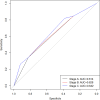A new stage for predicting the prognosis of granulomatous lobular mastitis
- PMID: 40106498
- PMCID: PMC11922289
- DOI: 10.1371/journal.pone.0319956
A new stage for predicting the prognosis of granulomatous lobular mastitis
Abstract
Introduction: The prognosis of granulomatous lobular mastitis (GLM) had been poor, primarily due to the lack of a unified disease assessment standard.
Objective: The purpose of this cohort study was to establish a staging system for GLM to more accurately evaluate the prognosis of patients.
Methods: This study retrospectively collected data from 264 GLM patients who visited our hospital between January 2017 and December 2023. Through logistic regression analysis, factors associated with prognosis were identified, which served as the basis for creating a new staging system.
Results: Univariate and multivariate logistic regression analysis revealed that hyperlipidemia (HR: 2.031; 95% CI: 1.100-3.750) and microabscesses (HR: 2.087; 95% CI = 1.138-3.827) were significant independent risk factors affecting the prognosis of GLM patients. Based on the results of logistic analysis, three different stages were ultimately established, and it was found that stage C had the highest AUC value (AUC: 0.642), followed by stage B (AUC: 0.628), with stage A (AUC: 0.614) having the lowest. The Delong test revealed no significant difference in AUC values between stage A and stage B (P = 0.255), nor between stage B and stage C (P = 0.263). However, the AUC value of the stage C was found to be higher than that of stage A (P < 0.001). Given that stage C has the highest AUC value, this study selected stage C as the final stage for evaluating the prognosis of GLM patients and named it the 1st edition of GLM stage.
Conclusions: This study constructed a rigorous and widely applicable GLM staging system (the 1st edition of GLM stage). The system demonstrated good predictive outcomes and provided strong support for clinical decision-making.
Copyright: © 2025 Wu et al. This is an open access article distributed under the terms of the Creative Commons Attribution License, which permits unrestricted use, distribution, and reproduction in any medium, provided the original author and source are credited.
Conflict of interest statement
The authors have declared that no competing interests exist.
Similar articles
-
Development of a machine learning-based diagnostic model using hematological parameters to differentiate periductal mastitis from granulomatous lobular mastitis.Sci Prog. 2025 Apr-Jun;108(2):368504251333513. doi: 10.1177/00368504251333513. Epub 2025 Apr 13. Sci Prog. 2025. PMID: 40223288 Free PMC article.
-
Management of granulomatous lobular mastitis: an international multidisciplinary consensus (2021 edition).Mil Med Res. 2022 Apr 26;9(1):20. doi: 10.1186/s40779-022-00380-5. Mil Med Res. 2022. PMID: 35473758 Free PMC article.
-
Construction of a Multi-Indicator Model for Abscess Prediction in Granulomatous Lobular Mastitis Using Inflammatory Indicators.J Inflamm Res. 2024 Feb 1;17:553-564. doi: 10.2147/JIR.S443765. eCollection 2024. J Inflamm Res. 2024. PMID: 38323114 Free PMC article.
-
The discriminatory diagnostic value of multimodal ultrasound combined with blood cell analysis for granulomatous lobular mastitis and invasive ductal carcinoma of the breast.Clin Hemorheol Microcirc. 2024;86(4):481-493. doi: 10.3233/CH-231999. Clin Hemorheol Microcirc. 2024. PMID: 38007642
-
Bacteria Associated with Granulomatous Lobular Mastitis and the Potential for Personalized Therapy.J Invest Surg. 2022 Jan;35(1):164-170. doi: 10.1080/08941939.2020.1833262. Epub 2020 Oct 15. J Invest Surg. 2022. PMID: 33059500 Review.
References
-
- Zuo X, Shi X, Gao X, Lai R, Liu P, Zhao Z. A retrospective study on 221 patients with granulomatous lobular mastitis treated by a combination of traditional Chinese medicine and western medicine. Ann Ital Chir. 2021;92:135–41. - PubMed
MeSH terms
LinkOut - more resources
Full Text Sources


